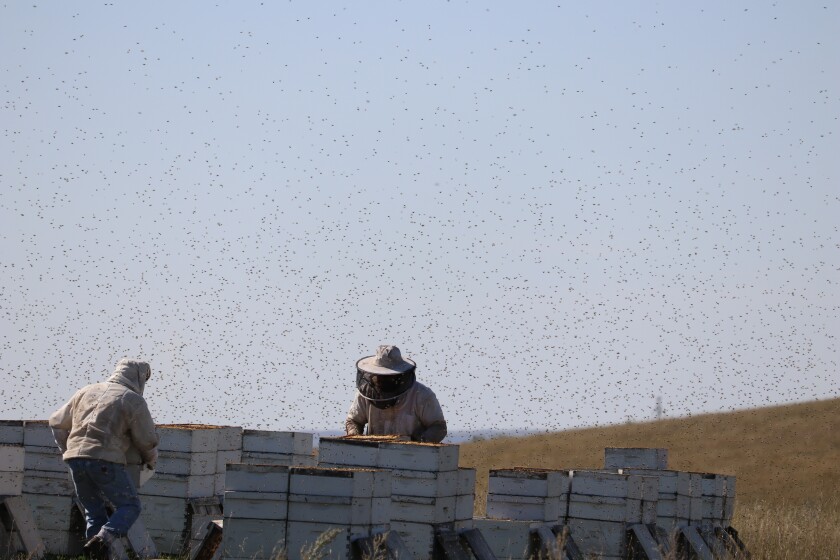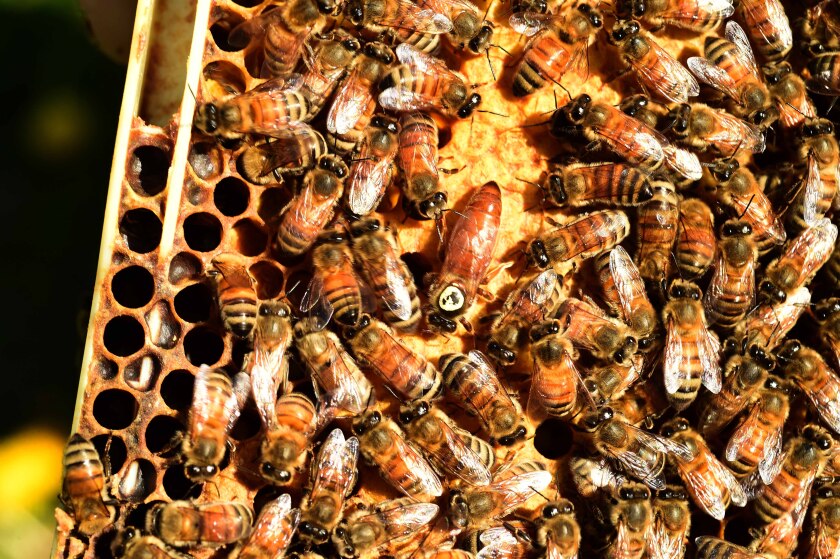Researchers and honey industry investigate the deaths of over half the nation's honeybee colonies
After hearing whispering and outcries from commercial beekeepers about their colonies dying sporadically and mysteriously, Project Apis m. — a leading organization in the world of honeybees — conducted a large-scale survey. Nearly 850 beekeepers responded to the survey, representing about 72% of the nation’s bee colonies. The results were staggering.
According to an April 3 press release from Project Apis m., the Honey Bee Health Coalition, the American Beekeeping Federation and the American Honey Producers Association, about 1.6 million colonies in the U.S. died over the winter months, a deeply concerning number considering there are typically about 3 million bee colonies in the U.S. The losses include about 62% of the colonies of commercial beekeepers, 54% of "sideliner" or midsized operations' colonies and 51% of hobbyist beekeepers' colonies.
Bee Colonies Lost Across Country
An unknown culprit is killing over half the nation's bee colonies. I met with some industry experts to learn more about these mysterious deaths and the impact it will have on commercial bee keeping, and agriculture, in this week's Agweek cover story.
0 seconds of 2 minutes, 44 secondsVolume 90%
While an investigation and research are still underway, no one knows yet what has caused the deaths. But they do know it's going to be costly.
Join the conversation
What's your biggest concern about bee colony losses?Leave a comment below and let us know what you think.
Read the Comments
The beekeeping and honey organizations have estimated the economic impact at $600 million from lost honey production, pollination income and costs to replace colonies. Associated impacts may be felt later in shortages of pollinated crops and reduced yields of some crops, which could lead to higher prices and limited grocery store availability.
“Beekeeping businesses are facing unprecedented challenges that threaten their survival from colony losses we haven’t seen in nearly 20 years. The swift response from stakeholders and the USDA is critical in providing beekeepers with the data and information to make well informed decisions to sustain their operations,” Patty Sundberg, president of the American Beekeeping Federation, said in a statement.
Bee ranchers

Beekeepers across the U.S. at all levels of the industry are concerned about loss of bee colonies. Photo taken Sept. 10, 2018.
Jenny Schlecht / Agweek file photo
While many people may not think of honeybees as livestock, they are for commercial beekeepers. Just as a cattle rancher depends on keeping their cattle alive to make a profit, commercial beekeepers rely on keeping their colonies alive to make a livelihood.
“It's going to mean a lot of kind of financial stress for a lot of the beekeepers,” Katie Lee, University of Minnesota Extension apiculture educator, said. “They keep honeybees as a living so their honeybees are like their livestock.”
One issue commercial beekeepers are facing when building back their colonies is that colonies take months to rebuild, so the turn-around time is not a quick process. There are some government assistance programs they can apply for, such as the Emergency Livestock Assistance Program.
But some commercial beekeepers are worried the assistance will not come quickly enough or be enough to sustain them.

John Miller of Miller Honey is worried about massive losses to bee colonies. Photo taken May 29, 2020.
Jenny Schlecht / Agweek
“It takes a lot of money to get your outfit from the California almonds back into central North Dakota. It takes a lot of freight. You gotta pay your truckers. You got to pay your employees. You got to buy that syrup to feed those bees, because, like cattleman knows, feed is not expensive until denied,” John Miller said.
Miller owns Miller Honey Farms, located in Gackle, North Dakota, which was started in 1969. Over the years the Millers have added to their commercial bee operation and even have an indoor wintering facility — a place where the bees in the winter enter dormancy. Miller has a unique perspective when it comes to the current commercial beekeeping crisis, as he has seen the industry evolve over the decades.
“I'm a lifer. My father was a beekeeper. His father was a beekeeper. His father was a beekeeper. My son is a beekeeper. My grandson is a beekeeper,” Miller said “I see two generations below me and I am able to reference two generations that were older than me. So I've kind of had this front row seat in the evolution of beekeeping.”

It is estimated that a honeybee colony consists of anywhere from 15,000 to 20,000 bees coming out of winter, and can grow up to around 50,000 bees during the summer. Photo taken May 8, 2017.
Scott Takushi / St. Paul Pioneer Press
An unknown culprit
When Project Aphis m. sent out their survey about the dying colonies, they were shocked at the response rate. But for industry leaders, the response rate was confirmation that commercial beekeepers everywhere were facing a colony collapse crisis. However, researchers were not able to pinpoint a cause of the death that is plaguing bee colonies.
“So it's a pretty big concern for beekeepers, and in part because we also don't know why. So the survey asked quite a few questions to try to get at some of the common causes, but nothing really came up,” Lee said.
While loss of bee colonies of this magnitude is unprecedented in the U.S., there was a similar scenario that happened in 2006, though at a smaller scale. According to Lee it was called colony collapse disorder.
While it is still not confirmed what is plaguing the bee colonies, Miller has a hunch.
“I think this is my opinion, but I think it's varroa and everything else. The lack of pasture is a factor. Pesticides in the open environment are, to a degree, a hazard,” he said.
Varroa are microscopic mites which are a debilitating parasite to honeybees and can cause a loss of honey production. Miller said making sure beekeepers are keeping good hive health, especially during this time of uncertainty, is paramount.
“Varroa is a dirty needle, and those viruses and the pathogens echo through the super organism after the mite is dead. Those pathogen loads persist in the colony longer than we had previously believed, and so just keep your outfit clean,” Miller said.

Researchers across the U.S. are investigating the cause of widescale winter die-offs in the country's bee population.
Trevor Peterson / Agweek file photo
The April 3 press release from the honey industry groups said the U.S. Department of Agriculture's Agricultural Research Service is having researchers analyze samples from 114 colonies in California, including both failing and surviving colonies. The industry expects the tests to offer insight into the situation. The ARS scientists are conducting pathogen screening for known diseases, examining stored pollen for pesticide contamination and plant diversity, identifying previously unknown pathogens in colonies with high disease prevalence, and assessing gut bacterial diversity and potential links to colony health, the release said.
Dr. Scott McArt’s laboratory at Cornell University is conducting pesticide residue analysis on bees, wax, pollen, and honey samples collected from affected colonies. USDA-ARS and university labs across the nation are analyzing potential contributing factors, including varroa mite resistance to amitraz, which is commonly used to control the mites, weather conditions and other environmental factors affecting colony health, management factors like queen replacement, supplemental nutrition and winter management, and chemical exposures.
“The U.S. Department of Agriculture is aware of the unusual losses to our nation’s honeybee colonies and is concerned about its potential impact on food production and supply,” the USDA said in a statement. “USDA Agricultural Research Service scientists are working closely with federal partners, stakeholders, and impacted parties to identify the source of this agricultural challenge. USDA will share more information when data is available.”
Steven Coy, president of the American Honey Producers Association, said the response from science and industry has been "impressively swift."
“We are grateful for the urgency and dedication shown throughout this process,” he said.
More from Emily Beal

Highly Pathogenic Avian Influenza ravages poultry barns and grocery store aisles
Mar 24
2

Dakota Sky Stone sells authentic and ethically sourced jewelry
Mar 3

North Dakota State University's Saddle and Sirloin club to host 99th annual Little International
Feb 14

Generation Z is making food purchases differently than previous generations
Feb 3
However, Miller and others are concerned that federal funding cuts to USDA will be harmful to getting answers. Chris Stelzig, executive director of the Entomological Society of America, in a piece published on Entomology Today on March 5 said entomologists studying threats to pollinator health were among researchers fired.
"The work performed by these scientists plays a critical role in protecting national agricultural biosecurity," he said, noting the need for urgent research given the winter bee die-offs.
Miller said with the small number of pollinator researchers in the country, firing a few could have devastating effects.
"You've poured out bee research in the United States of America," he said.
Impact on agriculture

Covered in pollen, a honey bee lands on the surface of a sunflower near Emerado, North Dakota, on Tuesday, July 26, 2016.
Nick Nelson / Agweek file photo
North Dakota is the No. 1 honey producing state in the U.S. According to Lee, there are more bees in North Dakota during the summer months than in any other state, with more than 800,000 registered colonies. Although most North Dakota crops are not dependent on bee pollination, some of the state's crops, including canola, dry edible beans, buckwheat and sunflowers, have been shown to benefit greatly from it.
"Beekeepers, actually have a significant impact on the ag industry in North Dakota because of all of that honey production. So I would argue that there is pretty high potential for this loss to impact the state of North Dakota, too," she said.
Some may say bees are the backbone of agriculture, their pollination is critical in the success of many commodities, such as almonds, blueberries, cranberries and other crops. Beekeepers take their colonies to the almond production areas, not to make honey but to have the bees pollinate.
“Almonds are basically the largest pollination event in the world. It's about a million acres of blooming almonds, which means it requires 2 million honey bee colonies. And while the beekeepers are paid quite a bit for their colonies, it's also a huge, kind of stressful event for everyone. You truck these colonies out. Bees get stolen. Bees get exposures to different things like pesticides,” Lee said.
She believes some beekeepers are weighing if the big pollination events are worth sending their colonies to, as it is an added risk to an already fragile event for the bees.
“I think it's going to be industry changing in part because of how it's going to affect the individual beekeeper's finances going forward,” Lee said. “I just think this loss was so financially devastating for so many people that doing the same thing again isn't necessarily going to be an option.”

댓글
댓글 쓰기